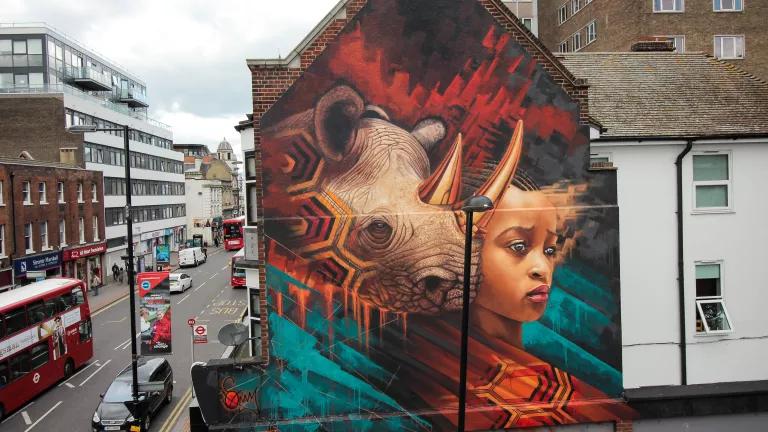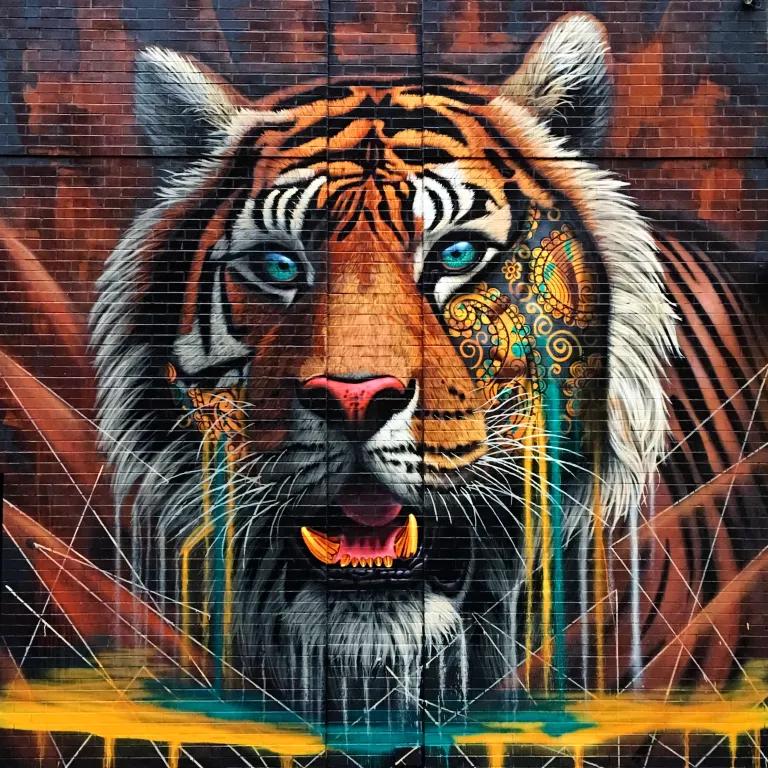National Identity and Wildlife Vividly Collide in This Street Art
For South African artist Sonny, biodiversity loss cuts “To the Bone.”

"Looking to Tomorrow," London
Seven years ago in Johannesburg, South Africa, a guitarist in a rock band impulsively decided to redecorate the group’s practice space. With no formal training or experience other than sketching in a notebook, he picked up an airbrush and covered the walls and ceiling with billowing clouds painted in a style inspired by Japanese manga.
“It was just a random thing that I decided to do one day,” says Sonny, the self-taught artist who signs his work with a single name. In 2014, Sonny painted his first large-scale mural on the side of an abandoned building in the Johannesburg’s gritty New Doornfontein neighborhood—a giant tiger poised to leap into the sky.
Today, Sonny is a star of the international street art scene, his vibrantly colorful images of wild animals covering the façades of buildings in cities all over the world. His massive portrait of a bleeding male lion peers majestically from a wall high above an intersection in New York’s Lower East Side. In London, a rhino with solid gold horns takes up the side of a three-story building. And in Amsterdam, his mural of a tiger moving through layers of flames and glass-like shards grabs the attention of visitors outside of what will be a new harborside museum.
Sonny’s eye-catching murals, created during his recent “To the Bone” world tour that culminated with an exhibition of smaller works in New York City earlier this year, are more than just arresting images of wildlife; they carry what the artist calls “hidden messages” about the uncertain future of the planet’s biodiversity. Patches of each animal’s face or body are peeled away to reveal the teeth and bones below, which are painted in gold as a reminder of the cold cash value of certain animal body parts on the global market. Bits and pieces of the animals’ faces float away into the background, as if the creatures are disintegrating before our eyes.
Though subtle, the harsh truths embedded in the paintings tell the story of what we are losing though trophy hunting, habitat degradation, and illegal trade. “The idea here is that you initially look at it and go, ‘Oh wow, what a beautiful animal.’ Then it’s, ‘Oh, wow, what is happening there?’” says Sonny, whose intention is to jolt viewers out of their complacency. “I always try to strike home to people that one day you might not be able to see this animal, or one day your son or daughter might not be able to see this animal.”

Sonny’s passion for wildlife goes back to his childhood in South Africa, where he immigrated with his family from the United Kingdom when he was 10. “Animals were my favorite thing when I was growing up,” he says. “We spent a lot of time on weekends and holidays camping in the wildlife preserves, and they just became my inspiration. I never lost that magic.” Concern about their welfare, not just in Africa but globally, came to him naturally. When Sonny started painting murals and discovered the power of art “to start conversations,” as he describes it, his interests coalesced in the “To the Bones” paintings.
Highlights of his year-long mural tour included collaborations with conservation groups like Project CAT, a partnership of the Discovery network and World Wildlife Fund that’s dedicated to doubling the number of tigers in the wild by 2022. Sonny’s mural of a tiger in New York’s SoHo neighborhood brings attention to the project’s work in India and Bhutan, where it has secured two million acres of land to support tigers. “It’s really, really positive work,” Sonny says. “Tigers have been on the decline for years—I think we lost like 96 percent in the 1970s—and now the population is actually increasing.” (Ten percent of the sales of Sonny’s “To the Bone” paint-on-canvas works go to Project CAT.)

Encouraging news like this helps keep Sonny’s spirits up, even if the plight of the world’s wild species are generally deteriorating. In many of his paintings, he covers the animals’ skulls with the traditional patterns of the countries where they live. Kicking Up Dust, for example, his giant depiction of a grizzly bear that faces high rates of hunting in British Columbia, incorporates the shapes and colors of blankets woven by Canada’s indigenous First Nations.
“It shows how intricately linked these animals are to the nations where they are native. If you’re African, you look at the African animals and think, What would we be without them?” says Sonny. “These animals are us. If we lose them, we lose a part of ourselves.”
This article was originally published on onEarth, which is no longer in publication. onEarth was founded in 1979 as the Amicus Journal, an independent magazine of thought and opinion on the environment. All opinions expressed are those of the authors and do not necessarily reflect the policies or positions of NRDC. This article is available for online republication by news media outlets or nonprofits under these conditions: The writer(s) must be credited with a byline; you must note prominently that the article was originally published by NRDC.org and link to the original; the article cannot be edited (beyond simple things such grammar); you can’t resell the article in any form or grant republishing rights to other outlets; you can’t republish our material wholesale or automatically—you need to select articles individually; you can’t republish the photos or graphics on our site without specific permission; you should drop us a note to let us know when you’ve used one of our articles.

"The Last Three" Bids a Sad Farewell to Rhinos on the Brink of Extinction
Haunting Views of a Planet Declining Faster for Some Communities Than for Others
How to Make an Effective Public Comment